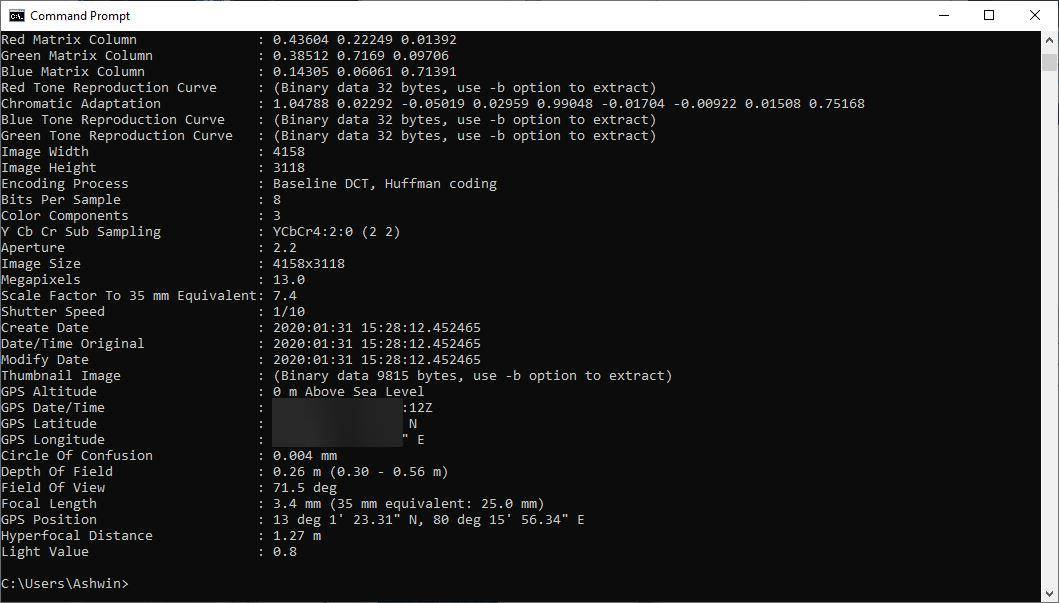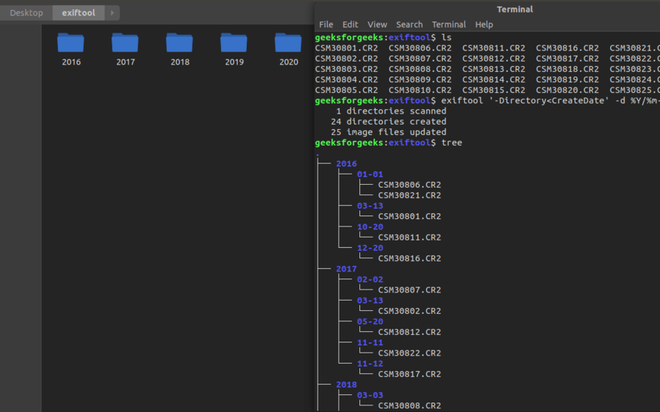

This is your "Command prompt", "Command line prompt", or "DOS prompt". This (usually) is a line that starts with the letter of the drive you are on and your current "path" followed by the greater than sign ">". Substitute your own drive letter for these.Īfter you open your "cmd window", or "DOS window", you will see some verbiage about your operating system and a "Dos prompt". This is the same as C, or D, or any other drive designation. Note: My examples will be on drives T, and U. While using ExifTool at the "Command Line" level, you really only need to know four DOS commands. Okay, let's jump right in at the deep end here. So next time you open the command window, relax. cmd (command) files can make short work of that typing. You need to type things instead of just clicking on icons with your mouse. Granted, doing things from the Dos prompt (Command Line) is more cumbersome. The overall reason for this boring section is to try and get people to relax around DOS. (That's got some people grinding their teeth right now, I'm sure of it)

#Exiftool command windows
When you open the "cmd window", instead of "running a program in Windows", you are "removing the Windows GUI from DOS". Most everything that is done in Windows can be done in DOS. However, I like to tell people that Windows is a GUI for DOS. Many people will argue that Windows IS an operating system and for the most part, it is. I point this out in the hopes of helping you realize the power of DOS. That's right! DOS was how computers worked before Windows. And that is look at the last two letters of the acronym. I offer this brief, abridged, history to make a simple point. A major step in computer evolution had been taken with this new Disk based Operating System. Now, only the basic instructions that were necessary to get the computer up and ready to read the OS from the disk was left on the computer everything else came from the disk. Then someone came up with the idea: "Why don't we put the OS on a disk?". Neither way was very appealing, and both took time and money. Updating your OS required one of two things.Ī) Take your computer into the shop and have them replace, or reprogram, the chip.ī) Buy a newer computer with the updated OS. Long, long ago, the OS (Operating System) for any computer was encoded on a chip inside the computer. The term DOS stood (stands) for "Disk Operating System". SKIP this entire section if you already know, or just don't care about a brief history of DOS. It is not intended to make you an expert in DOS (Unless you are, already, an expert). It is not intended to be the ultimate authority on the subject and, as such, may not include every possible command. And it is intended for everyone in between. It is intended for those who have mastered Dos commands, but just want to see what I have to say. This primer is intended for those who know nothing about DOS, the Command Line, or Dos Commands. " on the command line), and the EXIF Artist tag is updated for one of the images:Įverything You've NEVER Wanted to Know About DOS (Imagine this part centered as a header) Here is a screen shot of a cmd window showing an example ExifTool session where some specific tags are extracted from all images in the current directory (the current directory is represented by a ". You can also use ExifTool to read and write specific metadata. The steps would be:Ī) Type " exiftool" (without the quotes), then press SPACE.ī) Drag and drop an image file onto the cmd window. Instead of typing the file name in the command above, you may drag and drop the file onto the cmd window. This command will display the metadata from the specified image. In Windows XP, select "Run." from the start menu, then type "cmd" and press RETURN.ģ) Type ExifTool commands in the cmd window that appears.Ī basic ExifTool command looks something like this:.In Windows 7, search for "cmd" from the "Start" menu, then press RETURN.
#Exiftool command install
Here are the basic steps to get started running ExifTool from the command line in Windows:ġ) Follow these intructions to install ExifTool for command line use.Ģ) Click the Windows "Start" menu and run the "cmd" application.


(But I reserve the right to edit posts in this thread if necessary to improve accuracy and clarity.)
#Exiftool command free
Feel free to add to this thread with any specific examples you may find useful.


 0 kommentar(er)
0 kommentar(er)
